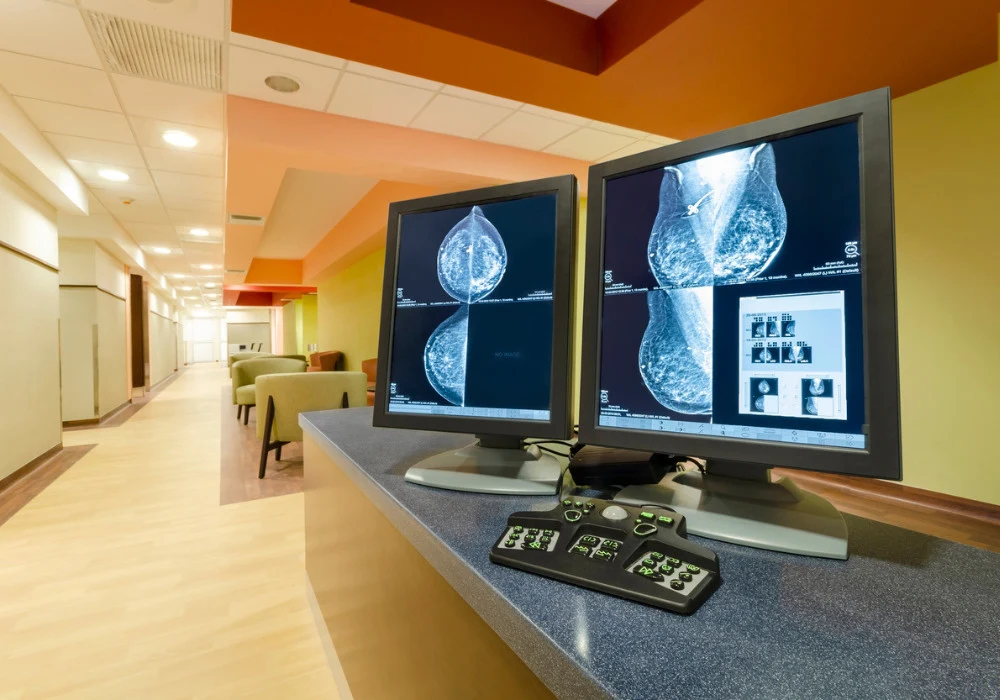Mammography plays a pivotal role in early detection of breast cancer. With the emergence of artificial intelligence (AI), there is increasing interest in its potential to enhance the accuracy and efficiency of mammography screening. Recent research has evaluated whether AI systems can replace human readers in double-reading workflows, which are standard in many breast cancer screening programs. A review published in Radiology: Artificial Intelligence discusses a population-wide study that compares three AI-integrated screening scenarios against traditional double reading, examining their feasibility, accuracy, and potential impact on workload.
Current Challenges and Opportunities in AI-integrated Mammography Screening
Artificial intelligence holds promise in mammography screening, potentially offering accuracy levels comparable to radiologists while reducing workload. However, questions about the generalisability and real-world application of AI systems remain, mainly due to previous studies having limitations such as small and non-representative sample sizes. A recent large-scale study attempted to address these issues by assessing the feasibility and accuracy of AI within a screening cohort of 249,402 mammograms. The study aimed to evaluate how well AI could replace one or both radiologists in double reading and how this might affect breast cancer detection accuracy and workflow efficiency.
Three AI-integrated scenarios were tested: replacing the first reader with AI (AIfirst), replacing the second reader (AIsecond), and using AI as a triage tool to classify screenings into low, moderate, or high risk (AItriage). These scenarios were compared to standard double reading with arbitration, a method where discrepancies between two independent readings are resolved by a third reader. The goal was to explore optimal sites for AI deployment within mammography screening workflows, aiming to reduce reading workload while maintaining or improving accuracy.
Performance Metrics and Outcomes of AI-integrated Scenarios
Each AI-integrated screening scenario was carefully analysed for its impact on cancer detection and workload. The primary metrics assessed were sensitivity (the ability to identify cancer cases correctly) and specificity (the ability to identify non-cancer cases correctly). Additional measures included positive predictive value (PPV), negative predictive value (NPV), recall rate, and arbitration rate. These metrics were used to compare the performance of AI-based screening scenarios against the standard combined double reading.
The study found that replacing the first reader with AI (AIfirst) maintained cancer detection accuracy without significant differences in metrics, except for a slight increase in the arbitration rate. Replacing the second reader (AIsecond) resulted in reduced sensitivity and recall rate but increased PPV and arbitration rate. The AItriage scenario, which used AI to identify low- and high-risk cases while maintaining human double reading for moderate-risk cases, demonstrated improved sensitivity, PPV, and NPV, alongside a reduced arbitration rate. Overall, each AI-integrated scenario led to a roughly 50% reduction in screen-reading workload compared to the standard double reading.
Clinical Implications and Optimal AI Deployment in Screening Workflows
The study's results suggest that integrating AI into mammography screening can be feasible and potentially beneficial, particularly regarding workload reduction. However, the specific impact on accuracy and efficiency depends on how AI is deployed within the screening workflow. For instance, replacing the first reader with AI maintained cancer detection rates while reducing the volume of human screen readings by nearly half. However, replacing the second reader, who was generally more experienced, resulted in decreased sensitivity, highlighting the importance of considering the experience level of the reader being replaced by AI.
Among the three scenarios, the AItriage approach was found to be the most promising, with improved performance across several key metrics. However, the legal and ethical implications of entirely replacing both readers with AI, particularly in clinical settings where guidelines require double reading, need to be addressed before broader implementation. Moreover, while the study demonstrated feasibility, further prospective trials are required to validate these findings in real-world settings, focusing on long-term outcomes, particularly interval cancer detection rates.
AI has the potential to significantly impact mammography screening by improving efficiency without compromising detection accuracy. The study examined three AI-integrated screening scenarios, finding that replacing one radiologist with AI could be a viable solution to reduce workload. The triage-based approach (AItriage) showed the best outcomes across performance metrics. However, deploying AI within screening workflows requires careful consideration of the role and experience of human readers being replaced and adherence to current clinical guidelines. Continued research and prospective trials will be crucial to validate these findings and ensure AI's optimal and safe integration into breast cancer screening programs.
Source: Radiology: Artificial Intelligence
Image Credit: iStock
References:
Elhakim M T, Stougaard S W, Graumann O et al. (2024) AI-integrated Screening to Replace Double Reading of Mammograms: A Population-wide Accuracy and Feasibility Study. Radiology: Artificial Intelligence. 6(6):e230529






